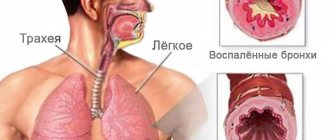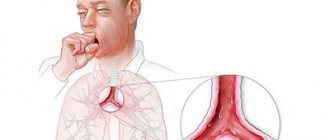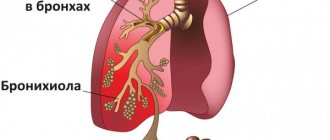What is the disease?
The pathology is characterized by inflammatory-obstructive changes in the lower respiratory tract. The course of smoker's bronchitis is progressive and is associated with prolonged exposure to combustion products on the body.
Important: for children, the problem of smoking should not be presented as a bad habit (a somewhat condescending and even neutral formulation), but as one of the types of domestic drug addiction, because that is what it is from a medical point of view.
Although there is an opinion in society that those who smoke and those who abstain get sick equally often, the statistics are inexorable: the main factor in the development and chronicization (that is, it is impossible to cure completely - only periodically stop exacerbations, achieving remission) of bronchopulmonary pathologies – tobacco abuse. These include not only smoker’s bronchitis, but also others - asthma, chronic obstructive pulmonary disease, which significantly worsen a person’s quality of life.
The process develops gradually and does not manifest itself with noticeable breathing disorders for a long time. The typical patient is a man over 35-40 years old who started this habit early and does not leave it for many years.
Reasons for rejection
The main factor is addiction to tobacco, with the duration of nicotine addiction, the number of cigarettes smoked daily, as well as gender and age being key factors.
Important: the severity of the effects of combustion products of tobacco smoke is the same both during direct smoking and during “passive” smoking, which is why smokers should begin to be more attentive to others, especially children, who, by inhaling smoke, also unwittingly become smokers.
Other factors may include unfavorable environmental conditions and work characteristics (occupational hazards).
Development mechanisms
Obstruction syndrome develops gradually, bronchial conduction is disrupted. At first, this occurs only during periods of exacerbation, and then becomes permanent due to fibrosis. The airways are blocked, and therefore hypoventilation develops.
The mechanism for the development of such consequences of smoking is as follows: firstly, combustion products can be both gaseous and solid-phase, and not only have an irritating effect on the respiratory tract, but also settle on them; secondly, the temperature of tobacco smoke is high, and therefore a person constantly exposes the mucous membrane to burns. As a consequence, an inflammatory process is formed, characterized by both morphological and functional changes in the epithelial cells lining the surface of the respiratory tract.
The process develops similarly if there is bronchitis of a bacterial nature. By understanding the mechanisms that occur in the bronchi under the influence of nicotine and smoke, you can independently figure out whether it is possible to smoke with bronchitis.
Diagnosis of smoker's bronchitis
Diagnosing smoker's bronchitis is not difficult. The diagnosis is based on the patient’s complaints (namely, the prevalence of cough in the clinical picture), details of the anamnesis (history) of the development of pathology, and the results of additional research methods.
When studying the medical history, the doctor clarifies such details as:
- for how long has the patient smoked;
- how many cigarettes a day does he smoke;
- does the patient take deep puffs?
- whether a similar disease was observed in other family members;
- whether other factors affect the patient’s body that can cause the development of respiratory pathologies.
Physical examination is informative at later stages of development of the described disease. The following is revealed:
- On general examination, the patient’s general condition is satisfactory, the skin and visible mucous membranes are pale pink. A patient's long history of smoking may result in a yellow color of the fingers and teeth - this is observed mainly in cases where the patient smokes cigarettes from a domestic manufacturer;
- upon local examination, there are generally no features, but in the later stages of pathology the chest may be deformed;
- during palpation (palpation) – vocal tremors may be increased (shaking of the chest wall during the patient’s phonation, which the doctor feels by placing his palms on the patient’s chest);
- during percussion (tapping) - generally without any peculiarities, but in the later stages a dull sound may occur during percussion;
- during auscultation (listening with a phonendoscope) - as the pathology progresses, hard vesicular breathing is heard, and during an exacerbation - multiple dry and moist rales.
Of the instrumental research methods in the diagnosis of smoker's bronchitis, the following are used:
bronchoscopy - a bronchoscope (endoscopic equipment) is inserted into the lumen of the bronchial tree and examined from the inside. With bronchitis, smokers notice unexpressed signs of inflammation in the form of redness and swelling, accumulation of sputum;- bronchography - under general anesthesia (anesthesia), the patient is injected into the bronchial tree with a contrast agent, and X-ray images are taken. Patients with long-term smoker's bronchitis may experience bronchial deformation;
- X-ray examination of the chest organs - in case of long-term pathology, X-ray images reveal indirect signs of smoker’s bronchitis in the form of pulmonary emphysema and their growth with connective tissue;
- spirometry - the patient makes a series of inhalations and exhalations, and also holds his breath, while the volume of air involved is measured, and based on the results of the examination, conclusions are drawn about the degree of respiratory failure.
Laboratory research methods used in the diagnosis of smoker's bronchitis include:
- general blood test - there is a slight but persistent increase in the number of leukocytes (leukocytosis) and ESR (erythrocyte sedimentation rate);
- determination of the gas composition of the blood - with long-term pathology, there is a decrease in the amount of oxygen in the blood and an increase in the amount of carbon dioxide;
- bacterioscopic examination - sputum is examined under a microscope, its characteristics (structure) are assessed, and the pathogen that could be attached is identified;
- bacteriological examination - culture of sputum is done on nutrient media, growth of colonies is expected, and the attached microflora is determined from them. Using this method, the sensitivity of the pathogen to antibacterial drugs is also determined - for this, cultures are done on nutrients with antibiotics.
Characteristic symptoms
The initial stage of the disease is characterized by the following manifestations:
- shortness of breath, especially during physical exertion;
- cough in the morning with thick, viscous discharge;
- acute respiratory viral infections are more severe and tend to be protracted;
The rate of deterioration of the condition will depend on how large the lesion is, how active the inflammatory process is, and how bronchial patency is impaired.
As the disease progresses, note:
- the cough becomes paroxysmal, and attacks become more frequent not only in the morning;
- smokers may wake up at night due to a strong cough, which worsens in the cool season, especially with high humidity;
- sputum - that is, mucus with impurities from the bronchi, which the patient coughs up, acquires a gray-brown color;
- the discharge may be characterized by a greenish tint, which is due to the presence of a purulent component;
- shortness of breath is provoked even by light physical exertion, and coughing attacks are provoked by deep breaths, windy weather, and cold air.
Sometimes the body temperature rises, general malaise, weakness, headaches, and excessive sweating occur.
Treatment of pathology
Treatment is long-term, course, because the disease is chronic. The most important condition is quitting smoking, as well as not only taking prescribed medications in a timely manner, but also lifestyle correction and an optimal diet. The disease is characterized by a long-term course, exacerbations are replaced by remissions, so it is so important to follow the recommendations not occasionally, but regularly.
The treatment regimen will depend on the patient's condition. Thus, anticholinergic drugs are prescribed, which reduce obstruction and help breathe easier. For example, bronchoalveolar lavage may also be required.
Medication
For periodic deterioration of the condition, bronchodilators are prescribed. This group of drugs helps improve bronchial conduction. For easier and faster evacuation of thick mucus, mucolytics are prescribed - drugs for the treatment of this type of disorder that effectively liquefy the discharge. In combination with basic medications, herbal preparations are used. If an infectious disease occurs, antibacterial and anti-inflammatory tablets are prescribed.
Suitable for inhalation are alkaline solutions, decoctions of medicinal plants, inhalation preparations diluted in saline solution, or pure saline solution. When choosing between wet steam and nebulizer inhalation, you should choose the second option.
Important. Immunomodulatory drugs and vitamin complexes, which are recommended by the attending physician upon discharge, should not be underestimated. These remedies will help you recover faster and return to general activity.
Nutrition should be balanced, the ratio of proteins, fats, carbohydrates for people who are engaged primarily in intellectual work is 1 (proteins) to 1.1 (fats) to 4.5 (carbohydrates). Don’t forget about the drinking regime - 2 liters of water, taking into account the liquid in food.
At home
Under no circumstances should you self-prescribe medications for smoker's bronchitis. There are often situations when friends give advice on how to treat a disease or recommend certain medications.
The dangers of no therapy
In the absence of qualified adequate medical care in the early stages, addiction persists even at the first signs of deterioration, smoker’s bronchitis develops into the initial stage of a serious pathology that will haunt the patient all his life - chronic obstructive pulmonary disease. Obstruction is an obstruction, in this case it means that the patient is experiencing breathing problems, which can ultimately be fatal.
The consequence of lack of treatment is a raw cough, whistling when breathing, shortness of breath, which is difficult to control. Due to hypoxic phenomena (that is, oxygen starvation due to obstruction of the respiratory tract), the smoker’s general condition worsens: complaints of regular headaches, weakness and high fatigue, deterioration of cognitive (mental) abilities.
Important: obstruction of the small bronchi manifests itself most severely. The condition provokes the development of chronic respiratory failure, circulatory pathologies (arterial hypertension, cardiac conduction disorders and its consequences). By the way, these factors predispose to the development of coronary heart disease, but mortality from cardiovascular pathologies in Russia is 57% of total mortality (in European countries it is slightly less).
Bronchitis is not always the result of a habit that has persisted for decades.
In some cases, the disease develops within 3-4 months after the start of smoking cigarettes, and immediately becomes chronic and progressive. The same applies to those who were constantly passive smokers (for example, children whose parents use cigarettes at home), and then themselves became addicted to this kind of domestic drug addiction.
Causes of chronic bronchitis in smokers
Chronic bronchitis in smokers is formed under the influence of several factors. The key ones are the following:
- Tobacco smoke damages mucous membranes and causes irritation.
- Tars and solid particles that are present in cigarette smoke settle on the surface of the bronchi and, in fact, paralyze their work. The natural process of cleansing the respiratory system is disrupted.
- The temperature of inhaled smoke can reach up to 60°C, so each cigarette leads to a slight burn, which only aggravates inflammation and slows down the recovery process of the mucous membranes.
Over time, this picture leads to functional and morphological changes in the bronchial epithelium. The cilia located on it normally react to any blockage (dust, sputum, etc.) and provoke coughing - clearing the respiratory tract. The constant influence of smoke leads to the fact that the motor activity of the cilia decreases, which means that various particles are retained in the bronchi and even the lungs. This creates a favorable environment for the development of bacteria, which is why smokers often suffer from infectious bronchitis and complications of ARVI. In addition, hyperplasia of the tracheobronchial glands may occur, which will affect the consistency of the mucus. The sputum becomes more viscous, and this only increases the risk of congestion.
The mucous membranes are responsible for local immunity, but constant exposure to smoke suppresses the activity of the immune system cells located here. The body's defenses are significantly reduced, which means that the risk of developing infectious diseases increases. Moreover, with this picture, bacteria and viruses are able to descend as low as possible through the respiratory tract. Therefore, against the background of smoker's bronchitis, people often suffer from frequent pneumonia.
Why is smoker's bronchitis dangerous?
You need to seek help from a pulmonologist in the following case: if the duration of inhalation is shorter than the duration of exhalation. In a normal state, exhalation and inhalation should be equal.
When smoking for a long time, it becomes difficult to take a deep breath. This may cause a cough.
People do not want to see a doctor, because treating smoker's bronchitis is impossible without quitting cigarettes. There are drugs that only to some extent help alleviate a person’s condition, and also reduce the negative effects of smoke on the walls of the bronchi.
Toxic substances from tobacco
Cough and other symptoms of smoker's bronchitis
Signs of dysfunction of the respiratory system appear on average after 10-15 years of smoking. But these terms are arbitrary, because the development of chronic bronchitis is quite individual. For example, in people who are prone to allergies and acute respiratory viral infections, the disease can make itself felt already in the first years of smoking. Polluted air also becomes an additional risk factor - in urban residents or workers in hazardous industries, bronchitis progresses much faster.
The first symptom of the disease is a morning cough. During the night, the epithelium is partially restored; after awakening, the cilia covering it are activated and free the bronchi from dirt. At this stage, we can say that there are no serious changes, and treatment for bronchitis can only consist of quitting smoking.
As the disease progresses, the following signs appear:
- The cough begins to bother you throughout the day and can occur after a loud conversation, laughter, or even intense breathing.
- Impurities of pus (yellow or greenish discharge) appear in the sputum, which indicate the addition of a bacterial infection.
- The mucus that is coughed up becomes thick and comes out in lumps.
Prevention of smoker's bronchitis
Preventive measures are based on quitting smoking and maintaining a healthy lifestyle:
- Review your diet and include healthy foods in your menu.
- Exercise.
- Do cool rubdowns in the morning.
- Allow sufficient time for proper rest.
- Avoid substances that irritate the respiration and bronchi.
- During cold periods, wear a face mask.
Preventive measures include vaccination against pneumococcal infection and influenza
Dangerous symptoms and complications: breathing problems
A person suffering from chronic bronchitis should stop smoking. Otherwise, the disease will develop and lead to life-threatening complications. People with a smoking history of 20 years or more may already have serious problems causing respiratory failure:
- bronchopneumonia,
- COPD (chronic obstructive pulmonary disease),
- pneumosclerosis,
- emphysema,
- pulmonary heart,
- throat and lung cancer.
The following symptoms indicate that health has deteriorated significantly and we are no longer talking only about bronchitis:
- Coughing up blood. Even minor traces of blood in sputum can indicate extremely dangerous diseases. For example, in 7% of patients with lung cancer, coughing up blood is the first symptom of the disease.
- Shortness of breath during physical activity of varying intensity. Talks about a decrease in lung volume, which is often observed in people who smoke.
- Shortness of breath that occurs in cold air and wind.
- Hoarseness and wheezing. Such symptoms may well indicate an acute respiratory infection, but in this case they will be accompanied by high fever, cough, runny nose, and a general deterioration in health. If they appear on their own and do not go away within 1-2 weeks, a consultation with a pulmonologist is necessary.
- Chest pain. This symptom may indicate problems with the lungs or heart.
Types of smoker's bronchitis
A smoker's cough not only has an unpleasant, sharp sound, but also causes suffering to the sick person. A deep cough coming from the lungs causes severe pain in the chest area.
If the disease has become chronic, its development occurs in two ways:
- Non-obstructive form of bronchitis . It is accompanied by a cough, production of sputum, mucus, but there are no ventilation disorders in the lungs.
- Obstructive nature of bronchitis . In this case, the airways narrow and swell, making it difficult for air to enter the lungs. The production of mucus increases, and the process of expectoration constantly occurs. The process of inhalation and exhalation is very difficult.
The type of bronchitis is determined by the nature of the mucus released when coughing:
- slimy;
- mucopurulent;
- purulent.
Treatment of smoker's bronchitis
Chronic bronchitis of a smoker cannot be started; the patient, even with initial symptoms, must consult a doctor. The main factor in successful therapy will be giving up cigarettes, and if a person is periodically bothered only by a morning cough, then such measures may be sufficient. Moreover, for 1-2 months after the patient quits smoking, attacks may intensify. This is a normal reaction of the body, because with the help of coughing, the mucous membranes are cleansed and restored.
If bronchitis is left untreated, after a few years the patient may require full-fledged therapy. However, in people with concomitant diagnoses, serious complications may appear after 6-12 months. Therefore, any treatment begins with a full diagnosis - studies of respiratory functions, bronchoscopy, X-ray of the lungs, sputum analysis and biochemical blood test.
Treatment of bronchitis during an exacerbation includes taking the main groups of medications:
- Mucolytics, which help thin and cough up mucus.
- Bronchodilators that relieve bronchospasm.
- Anti-inflammatory drugs.
- Antibiotics (if the exacerbation is caused by an associated bacterial infection).
In addition, the patient may be prescribed immunity-boosting drugs and vitamin complexes. Physiotherapeutic procedures, chest massages and sanatorium treatment help well.
During periods of remission, treatment of bronchitis is reduced to preventing exacerbations. Often this does not require drug therapy, but following the rules of a healthy lifestyle is quite enough. The following measures will help improve the condition of the respiratory system and prevent congestion:
- Drink plenty of fluids. Water helps thin mucus and improves metabolic processes.
- Breathing exercises.
- Sports activities. Outdoor exercise is especially beneficial; even daily walks in the park can improve the condition of the respiratory system.
- Allergy prevention. An allergic reaction can be caused by foods (milk, chocolate, fish, nuts, etc.), mold, dust, animal hair, and plant pollen.
Take the test
Smoker's bronchitis is an independent disease that affects almost every cigarette smoker with more than 15-20 years of experience.
A mild but obsessive cough progresses over time, and other symptoms develop.
A heavy smoker will have to face big health problems , especially when the disease becomes chronic. How to treat chronic bronchitis of a smoker?
How to treat smoker's bronchitis
Over time, a smoker’s quality of life significantly decreases, his general condition worsens, he begins to get tired quickly and feels irritated, which is why it is so important to diagnose the disease in time and begin proper treatment.
First of all, the patient needs to quit smoking.
Any, even the most modern treatment for such bronchitis will be meaningless if this is not done. The sooner measures are taken, the better the treatment result will be. A specialist will select medications for treatment.
It is necessary to start treatment when even the first cough and minor breathing problems appear. Sometimes in the early stages of smoker's bronchitis, an involution of symptoms may be observed - their reverse development. In the first few days, a person who quits smoking seems to feel that his health is deteriorating: the cough becomes very strong, and phlegm is constantly produced. However, in fact, this indicates the beginning of recovery, and also that the mucous membrane is beginning to recover.
Specialists begin treatment with drugs that relieve spasms in the bronchi, as well as dilute accumulated mucus.
Treatment of such bronchitis usually takes place at home, but under the supervision of a doctor. It lasts quite a long time. The first indispensable condition for successful treatment is quitting smoking . Any amount of cigarette smoke entering the lungs will negatively affect the outcome of therapy. If the disease is not advanced, then the drainage function of the lungs at first is able to recover on its own without additional drug treatment.
For people with chronic smoker's bronchitis, treatment will be prescribed using the following drugs:
- Bronchilitics. They are used in the treatment of bronchitis to relieve spasms in the lungs and normalize breathing.
- Mucolytic drugs. These products liquefy and remove mucus.
- Antihistamines that relieve swelling of the respiratory system.
- Sometimes antibiotic drugs can be used to treat smoker's bronchitis. This will be necessary if a bacterial infection has been added to the underlying disease.
All medications for the treatment of smoker's bronchitis are prescribed exclusively by a specialist. He should also be aware of what traditional medicines are used additionally.
The best effect is provided by inhalation drugs. At the beginning of the disease, they are used as necessary and with the permission of the attending physician; they are part of the main therapy when a smoker’s bronchitis has entered the middle stage or into a chronic form.
The inhalation dose and number of injections are determined by a specialist. He does this taking into account the age, weight, and general condition of the victim. If bronchitis has acquired a chronic form, then inhalation therapy will be lifelong.
In the case when chronic lung disease is in an acute stage or has been joined by other diseases or pathologies, the doctor will change the dosage of the drugs. If the patient’s breathing volume is significantly reduced, then additional medications are prescribed to relieve inflammation on a hormonal basis. The course of treatment with them is usually from one to two weeks. Then the doctor will prescribe additional procedures depending on the patient’s condition.
When, during sputum separation, its quantity increases sharply or pus appears in it, this is a reason to prescribe antibiotics. The patient must be registered with a general practitioner. If the specialist does not observe complications in the patient, then general treatment can be carried out on an outpatient basis.
The etiology of cough in humans can be completely different.
It is highly undesirable to suppress a cough due to bronchitis in a smoker using conventional cough suppressants.
Some of them do an excellent job with coughs in infectious diseases, but are completely useless or even dangerous in cases of obstructive pulmonary disease. It is necessary to accurately understand the mechanism of action of a particular cough remedy, as well as its composition, in order to help and not harm the patient. Therefore, under no circumstances should you self-medicate, because the consequences can be completely unpredictable.
Smoker's chronic bronchitis - symptoms and treatment
The irritating effects of tars, nicotine, and flavorings negatively affect the entire bronchopulmonary system. The human respiratory tract is lined with tiny cilia. These hairs purify the air going into the lungs.
Nicotine paralyzes the work of the cilia, as a result, toxins and toxic substances penetrate into the lungs, where they accumulate and provoke the development of inflammation. This process leads to the appearance of a cough - the body strives with all its might to get rid of harmful substances. Smoker's bronchitis occurs.
The first signs of smoker's bronchitis are observed at 35-40 years of age . And the disease reaches its peak at 60-65 years. Moreover, non-smokers who permanently live with a habitual smoker may also suffer. The lungs of “passive” smokers suffer no less!
How dangerous is the condition?
Chronic inflammation of the bronchi in combination with constant respiratory failure in smokers leads to disastrous consequences:
- chronic fatigue;
- fast fatiguability;
- oxygen starvation;
- problems in the functioning of internal organs;
- pathological deformations of the respiratory system;
- development of obstructive pulmonary disease (COPD).
Such consequences, which threaten the life and health of a smoker, are guaranteed if he has a frivolous attitude towards himself and an unwillingness to treat the underlying disease - bronchitis. How to recognize the onset of a pathological situation, and which doctor to go to?
Symptoms of smoker's bronchitis
does not develop immediately in smokers . The picture of pathology consists of three main signs. Doctors divide smoker's bronchitis into three stages, as symptoms develop:
| Symptom | Stage 1 | Stage 2 | Stage 3 (COPD) |
| Cough | The morning cough is dry, not strong, and does not occur every morning. The cough gradually becomes annoying and constant | The cough turns into a wet type, appears when inhaling | The cough is constant, strong and painful, paroxysmal, worsens with wind and cold air |
| Sputum | No sputum | The sputum is viscous, yellow-brown in color, a slight inclusion of purulent streaks can be seen in the mucus | Thick brown sputum with abundant purulent inclusions |
| Dyspnea | Shortness of breath develops during mild physical exertion (walking up the stairs to the 4th-5th floors, not long running) | Shortness of breath becomes inspiratory (occurring during inspiration), appears with moderate physical activity, gradually intensifies, leading the person to a semi-fainting state. | Severe shortness of breath, which occurs even with light exertion and even at rest, is accompanied by increased heartbeat (tachycardia), can cause loss of consciousness, and oxygen deprivation is noted |
In 80-90% of cases, chronic bronchitis of a smoker causes COPD . Chronic obstructive pulmonary disease is a progressive disease that permanently restricts the airflow into the lungs.
The pathology occurs with abnormal inflammatory processes in the lung tissue and leads the patient to disability, and in severe cases to death.
A feature of smoker's chronic bronchitis is the increase in irreversible pathological changes in all internal organs.
This process is caused by constant respiratory failure, due to which tissues and organs do not receive the necessary oxygen. What are the risks of chronic bronchitis for a smoker?
- vision weakens, cataracts develop;
- all metabolic processes of the body are disrupted;
- immunity decreases, any cold becomes more severe and difficult to treat;
- problems begin in the functioning of the heart (development of heart failure, tachycardia, hypertension);
- disturbance of brain activity (fatigue, drowsiness, decreased memory and coordination of movement, irritability, dizziness).
It is difficult to predict when a smoker's bronchitis will go from the initial stage to chronic. The development of the disease is influenced by a person’s age , characteristics of his body, smoking history, place of work and residence, diet and lifestyle.
Symptoms of smoker's bronchitis
Bronchitis in a smoker develops gradually; the main symptom, cough, may appear 5–10 years after the start of smoking. Various diseases, infections that have entered the respiratory tract and simply hypothermia of the body, all this can trigger the onset of the disease.
The disease goes through stages of development that are not very pronounced. At the first stage, there is a cough in the morning, which has a characteristic sound, hoarse and crackling.
Then other symptoms appear:
- cough, weak and infrequent at first, turning over time into a constant cough (with a viscous secretion, often dark in color, pus);
- shortness of breath appears with light exertion, when walking up the stairs at a normal pace;
- Frequent colds occur, often aggravated by complications.
At the second stage, a violation of the physiological balance of the body occurs, which is characterized by:
- shortness of breath, often followed by fainting;
- coughing when air suddenly enters the throat;
- increased heart rate during cold weather and gusts of wind.
The third stage of disease development indicates the onset of COPD and is characterized by symptoms:
- severe shortness of breath with minimal movement;
- difficulty breathing when lying on your back;
- chronic cough;
- persistent metabolic disorder in the body.
Long-term irritation of the bronchi by nicotine causes structural changes in them: the development of scar tissue, thickening of the walls.
Restoring health
A pulmonologist is a physician who specializes in respiratory problems and diagnoses and treats dangerous diseases.
After a preliminary diagnosis - listening to the lungs, bronchi and external visual examination, the doctor refers the patient to a number of examinations:
- Bronchoscopy . A method for examining the mucous tissue of the bronchi and trachea using a bronchoscope. The device is inserted through the patient's airway.
- Fluorography . A basic method to exclude the presence of pathologies other than bronchitis in a smoker: cancer, emphysema, tuberculosis.
- Blood tests (biochemical and general). While conducting the study, the laboratory technician analyzes the erythrocyte sedimentation time and the total level of leukocytes. This allows the doctor to understand whether there are hidden pockets of inflammation in the smoker’s body. Later stages of smoker’s bronchitis show an increase in hemoglobin - the body, in pathology, tries in this way to compensate and restore the deficit in gas exchange.
- Spirogram (analysis of the functionality of external respiration). Spirometry is a test that allows you to determine the amount of air exhaled, lung volume and other parameters important in making a diagnosis.
- Examination of discharged sputum with its culture for bacteriological analysis and testing for sensitivity to antibiotics.
Prognosis for smoker's bronchitis
The prognosis for smoker's bronchitis is generally favorable. The disease develops quite slowly, so there is every chance of stopping it at any stage of development. But for successful treatment, the patient must quit smoking once and for all.
The prognosis worsens in cases such as:
- late diagnosis and treatment;
- elderly age;
- combination with other diseases of the respiratory system.
Kovtonyuk Oksana Vladimirovna, medical observer, surgeon, consultant doctor
just today
( 55 votes, average: 4.45 out of 5)
Bronchiectasis: symptoms, diagnosis, treatment
Is it possible for a child with a cough to walk outside?
Related Posts
Victory over addiction
It is very difficult to give up such an addiction, especially for a person with a long history of smoking. But it is necessary to quit smoking, otherwise all treatment will be ineffective. You will have to muster all your willpower and study techniques and tips for quitting smoking.
An effective way is to undergo treatment with a psychotherapist . After all, the habit of smoking is a psychological addiction; it is formed at the level of psycho-emotional reactions.
When treating chronic bronchitis of a smoker, the patient is recommended to follow a gentle regimen, spend more time outside the city, and breathe fresh air. The living space must be regularly and thoroughly ventilated and the air humidified.
And remember, the sooner a smoker gives up his addiction, the more favorable the prognosis for treating bronchitis. The lower the risk of heart pathologies, oncology and respiratory failure.











